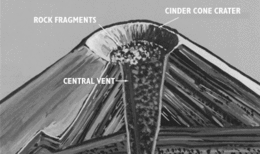Cinder cone

A cinder cone (or scoria cone
Mechanics of eruption

Cinder cones range in size from tens to hundreds of meters tall.
The pyroclastic material making up a cinder cone is usually
The growth of a cinder cone may be divided into four stages. In the first stage, a low-rimmed scoria ring forms around the erupting event. During the second stage, the rim is built up and a
During the waning stage of a cinder cone eruption, the magma has lost most of its gas content. This gas-depleted magma does not fountain but oozes quietly into the crater or beneath the base of the cone as lava. If the crater is fully breached, the remaining walls form an amphitheater or horseshoe shape around the vent.
Occurrence

Basaltic cinder cones are the most characteristic type of volcano associated with intraplate volcanism.[9] They are particularly common in association with alkaline magmatism, in which the erupted lava is enriched in sodium and potassium oxides.[10]
Cinder cones are also commonly found on the flanks of shield volcanoes, stratovolcanoes, and calderas.[3] For example, geologists have identified nearly 100 cinder cones on the flanks of Mauna Kea, a shield volcano located on the island of Hawaii.[3] Such cinder cones likely represent the final stages of activity of a mafic volcano.[11] However, most volcanic cones formed in Hawaiian-type eruptions are spatter cones rather than cinder cones, due to the fluid nature of the lava.[12]
The most famous cinder cone,
The Earth's most historically active cinder cone is Cerro Negro in Nicaragua.[3] It is part of a group of four young cinder cones NW of Las Pilas volcano. Since its initial eruption in 1850, it has erupted more than 20 times, most recently in 1995 and 1999.[3]
Satellite images suggest that cinder cones occur on other terrestrial bodies in the solar system.[13] On Mars, they have been reported on the flanks of Pavonis Mons in Tharsis,[14][15] in the region of Hydraotes Chaos[16] on the bottom of the Coprates Chasma,[17] or in the volcanic field Ulysses Colles.[18] It is also suggested that domical structures in Marius Hills (on the Moon) might represent lunar cinder cones.[19]
Effect of environmental conditions
The size and shape of cinder cones depend on environmental properties as different gravity and/or atmospheric pressure might change the dispersion of ejected scoria particles.[13] For example, cinder cones on Mars seem to be more than two times wider than terrestrial analogues[18] as lower atmospheric pressure and gravity enable wider dispersion of ejected particles over a larger area.[13][20] Therefore, it seems that erupted amount of material is not sufficient on Mars for the flank slopes to attain the angle of repose and Martian cinder cones seem to be ruled mainly by ballistic distribution and not by material redistribution on flanks as typical on Earth.[20]
Cinder cones often are highly symmetric, but strong prevailing winds at the time of eruption can cause a greater accumulation of cinder on the downwind side of the vent.[11]
Monogenetic cones

Some cinder cones are monogenetic, forming from a single short eruptive episode that produces a very small volume of lava. The eruption typically last just weeks or months, but can occasionally last fifteen years or longer.[21] Parícutin in Mexico, Diamond Head, Koko Head, Punchbowl Crater, Mt Le Brun from the Coalstoun Lakes volcanic field, and some cinder cones on Mauna Kea are monogenetic cinder cones. However, not all cinder cones are monogenetic, with some ancient cinder cones showing intervals of soil formation between flows that indicate that eruptions were separated by thousands to tens of thousands of years.[21]
Monogenetic cones likely form when the rate of magma supply to a volcanic field is very low and the eruptions are spread out in space and time. This prevents any one eruption from establishing a system of "
See also
- List of cinder cones
- Volcanic cone – Landform of ejecta from a volcanic vent piled up in a conical shape
- Capulin Volcano National Monument – U.S. National Monument in New Mexico
References
- ISBN 9780199653065.
- ^ ISBN 978-3-642-65152-6.
- ^ a b c d e f g h i j
 This article incorporates public domain material from Photo glossary of volcano terms: Cinder cone. United States Geological Survey.
This article incorporates public domain material from Photo glossary of volcano terms: Cinder cone. United States Geological Survey.
- ISSN 0377-0273.
- ISBN 3540127569.
- ISBN 0922152349.
- ^ Fisher & Schmincke 1984, p. 150.
- ^ a b c d
 This article incorporates public domain material from Susan S. Priest; Wendell A. Duffield; Nancy R. Riggs; Brian Poturalski; Karen Malis-Clark (2002). Red Mountain Volcano – A Spectacular and Unusual Cinder Cone in Northern Arizona. United States Geological Survey. USGS Fact Sheet 024-02. Retrieved 2012-05-18.
This article incorporates public domain material from Susan S. Priest; Wendell A. Duffield; Nancy R. Riggs; Brian Poturalski; Karen Malis-Clark (2002). Red Mountain Volcano – A Spectacular and Unusual Cinder Cone in Northern Arizona. United States Geological Survey. USGS Fact Sheet 024-02. Retrieved 2012-05-18.
- ^ Fisher & Schmincke 1984, p. 14.
- ^ Fisher & Schmincke 1984, p. 198.
- ^ ISBN 0314921958.
- ISBN 0824808320.
- ^ )
- .
- .
- .
- .
- ^ .
- .
- ^ .
- ^ ISBN 978-3-540-43650-8.
- .
- ^ "Monogenetic fields". Volcano World. Oregon State University. 15 April 2010. Retrieved 17 December 2021.
External links
 Media related to Cinder cones (category) at Wikimedia Commons
Media related to Cinder cones (category) at Wikimedia Commons

